Phytic Acid in Brown Rice Can Be Reduced by Increasing Soaking Temperature
Abstract
1. Introduction
2. Materials and Methods
2.1. Seed Germination
2.2. Phytase Activity Assay
2.3. Determination of PA
2.4. Determination of Zn Content
2.5. Data Analysis
3. Results
3.1. The Effect of Temperature on Soaking
3.2. Optimum Temperature of Phytase Activity Derived from Non-Soaked Grain
3.3. The Effect of Soaking Temperature on Phytase Activity and PA Content
3.4. The Effect of Soaking Temperature on Phytase Activity and PA Content within 48 h
3.5. Estimation of Zn Bioavailability in GBR
4. Discussion
4.1. The Thermal Stability of Phytase
4.2. Effect of Temperature on PA Degradation
4.3. To Produce High Zn Bioavailable GBR
5. Conclusions
Author Contributions
Funding
Data Availability Statement
Conflicts of Interest
References
- United Nations, World Population Prospects 2019: Highlights. Available online: https://population.un.org/wpp/Publications/Files/WPP2019_Highlights.pdf (accessed on 23 December 2020).
- Kubo, M.; Purevdorj, M. The Future of Rice Production and Consumption. J. Food Distrib. Res. 2004, 35, 128–142. [Google Scholar]
- Ravichanthiran, K.; Ma, Z.F.; Zhang, H.; Cao, Y.; Wang, C.W.; Muhammad, S.; Aglago, E.K.; Zhang, Y.; Jin, Y.; Pan, B. Phytochemical profile of brown rice and its nutrigenomic implications. Antioxidants 2018, 7, 71. [Google Scholar] [CrossRef] [PubMed]
- Aune, D.; Chan Doris, S.M.; Lau, R.; Vieira, R.; Greenwood, D.C.; Kampman, E. Dietary fibre, whole grains, and risk of colorectal cancer: Systematic review and dose-response meta-analysis of prospective studies. Br. Med. J. 2011, 343, d6617. [Google Scholar] [CrossRef] [PubMed]
- Aune, D.; Chan, D.S.; Greenwood, D.C.; Vieira, A.R.; Rosenblatt, D.A.; Vieira, R.; Norat, T. Dietary fiber and breast cancer risk: A systematic review and meta-analysis of prospective studies. Ann. Oncol. 2012, 23, 1394–1402. [Google Scholar] [CrossRef] [PubMed]
- Kazemzadeh, M.; Safavi, S.M.; Nematollahi, S.; Nourieh, Z. Effect of brown rice consumption on inflammatory marker and cardiovascular risk factors among overweight and obese non-menopausal female adults. Int. J. Prev. Med. 2014, 5, 478–488. [Google Scholar] [PubMed]
- Liu, R.H. Whole grain phytochemicals and health. J. Cereal Sci. 2007, 46, 207–219. [Google Scholar] [CrossRef]
- Cho, D.H.; Lim, S.T. Germinated brown rice and its bio-functional compounds. Food Chem. 2016, 196, 259–271. [Google Scholar] [CrossRef]
- Roboy, V. Approaches and challenges to engineering seed phytate and total phosphorus. Plant Sci. 2009, 177, 281–296. [Google Scholar] [CrossRef]
- Raboy, V. myo-Inositol-1,2,3,4,5,6-hexakisphosphate. Phytochemistry 2003, 64, 1033–1043. [Google Scholar] [CrossRef]
- Lönnerdal, B.; Mendoza, C.; Brown, K.H.; Rutger, J.N.; Raboy, V. Zinc absorption from low phytic acid genotypes of Maize (Zea mays L.), Barley (Hordeum vulgare L.), and Rice (Oryza sativa L.) assessed in a suckling rat pup model. J. Agric. Food Chem. 2011, 59, 4755–4762. [Google Scholar] [CrossRef]
- Kumar, V.; Sinha, A.K.; Makkar, H.P.S.; Becker, K. Dietary roles of phytate and phytase in human nutrition: A review. Food Chem. 2010, 120, 945–959. [Google Scholar] [CrossRef]
- Perera, I.; Seneweera, S.; Hirotsu, N. Manipulating the phytic acid content of rice grain toward improving micronutrient bioavailability. Rice 2018, 11, 4. [Google Scholar] [CrossRef] [PubMed]
- Iwai, T.; Takahashi, M.; Oda, K.; Terada, Y.; Yoshida, K.T. Dynamic changes in the distribution of minerals in relation to phytic acid accumulation during rice seed development. Plant Physiol. 2012, 160, 2007–2014. [Google Scholar] [CrossRef] [PubMed]
- Perera, I.; Fukushima, A.; Akabane, T.; Horiguchi, G.; Seneweera, S.; Hirotsu, N. Expression regulation of myo-inositol 3-phosphate synthase 1 (INO1) in determination of phytic acid accumulation in rice grain. Sci. Rep. 2019, 9, 14866. [Google Scholar] [CrossRef] [PubMed]
- Fukushima, A.; Perera, I.; Hosoya, K.; Akabane, T.; Hirotsu, N. Genotypic differences in the effect of P fertilization on phytic acid content in rice grain. Plants 2020, 9, 146. [Google Scholar] [CrossRef]
- Shi, J.; Wang, H.; Hazebroek, J.; Ertl, D.S.; Harp, T. The maize low-phytic acid 3 encodes a myo-inositol kinase that plays a role in phytic acid biosynthesis in developing seeds. Plant J. 2005, 42, 708–719. [Google Scholar] [CrossRef]
- Raboy, V.; Peterson, K.; Jackson, C.; Marshall, J.M.; Hu, G.; Saneoka, H.; Bregitzer, P. A substantial fraction of barley (Hordeum vulgare L.) low phytic acid mutations have little or no effect on yield across diverse production environments. Plants 2015, 4, 225–239. [Google Scholar] [CrossRef]
- Jiang, M.; Liu, Y.; Liu, Y.; Tan, Y.; Huang, J.; Shu, Q. Mutation of Inositol 1,3,4-trisphosphate 5/6-kinase6 Impairs Plant Growth and Phytic Acid Synthesis in Rice. Plants 2019, 8, 114. [Google Scholar] [CrossRef]
- Watchararparpaiboon, W.; Laohakunjit, N.; Kerdchoechuen, O. An improved process for high quality and nutrition of brown rice production. Food Sci. Technol. Int. 2010, 16, 147–158. [Google Scholar] [CrossRef]
- Trachoo, N.; Boudreaux, C.; Moongngarm, A.; Samappito, S.; Gaensakoo, R. Effect of geminated rough rice media on growth of selected probiotic bacteria. Pak. J. Biol. Sci. 2006, 9, 2657–2661. [Google Scholar] [CrossRef]
- Kumari, S.; Krishnan, V.; Jolly, M.; Sachdev, A. In vivo bioavailability of essential minerals and phytase activity during soaking and germination in soybean (Glycine max L.). Aust. J. Crop Sci. 2014, 8, 1168–1174. [Google Scholar]
- Mahesh, S.; Pavithra, G.; Parvathi, M.; Reddy, R.; Shankar, A. Effect of processing on phytic acid content and nutrient availability in food grains. Int. J. Agric. Sci. 2015, 5, 771–777. [Google Scholar]
- Azeke, M.A.; Egielewa, S.J.; Eigbogbo, M.U.; Ihimire, I.G. Effect of germination on the phytase activity, phytate and total phosphorus contents of rice (Oryza sativa), maize (Zea mays), millet (Panicum miliaceum), sorghum (Sorghum bicolor) and wheat (Triticum aestivum). J. Food Sci. Technol. 2011, 48, 724–729. [Google Scholar] [CrossRef] [PubMed]
- Bouajila, A.; Ammar, H.; Chahine, M.; Khouja, M.; Mohamed, A.Z. Changes in phytase activity, phosphorus and phytate contents during grain germination of barley (Hordeum vulgare L.) cultivars. Agrofor. Syst. 2020, 94, 1151–1159. [Google Scholar] [CrossRef]
- Nielsen, P.H.; Wenzel, H. Environmental assessment of Ronozyme® P5000 CT phytase as an alternative to inorganic phosphate supplementation to pig feed used in intensive pig production. Int. J. Life Cycle Assess. 2007, 12, 514–520. [Google Scholar] [CrossRef]
- Rebello, S.; Jose, L.; Sindhu, R.; Aneesh, E.M. Molecular advancements in the development of thermostable phytases. Appl. Microbiol. Biotechnol. 2017, 101, 2677–2689. [Google Scholar] [CrossRef] [PubMed]
- Parhamfar, M.; Badoei-Dalfard, A.; Khaleghi, M.; Hassanshahian, M. Purification and characterization of an acidic, thermophilic phytase from a newly isolated Geobacillus stearothermophilus strain DM12. Prog. Biol. Sci. 2015, 5, 61–73. [Google Scholar]
- Ou, K.; Cheng, Y.; Xing, Y.; Lin, L. Phytase activity in brown rice during steeping and sprouting. J. Food. Sci. Technol. 2011, 48, 598–603. [Google Scholar] [CrossRef]
- Bradford, M. A rapid and sensitive method for the quantitation of microgram quantities of protein utilizing the principle of protein-dye binding. Anal. Biochem. 1976, 72, 248–254. [Google Scholar] [CrossRef]
- Perera, I.; Fukushima, A.; Arai, M.; Yamada, K.; Nagasaka, S.; Seneweera, S.; Hirotsu, N. Identification of low phytic acid and high Zn bioavailable rice (Oryza sativa L.) from 69 accessions of the world rice core collection. J. Cereal Sci. 2019, 85, 206–213. [Google Scholar] [CrossRef]
- Farouk, A.A.; Ahamed, N.T.; Shobirin, A.; Hussin, M.; Al Zahrani, O.; Alotaibi, S. Optimization of the conditions for rice bran phytate degradation by their own phytases. J. Appl. Biol. Biotechnol. 2018, 6, 42–46. [Google Scholar]
- Yu, P.; Chen, Y. Purification and characterization of a novel neutral and heat-tolerant phytase from a newly isolated strain Bacillus nealsonii ZJ0702. BMC Biotechnol. 2013, 13, 78. [Google Scholar] [CrossRef] [PubMed]
- Fasimoye, F.O.; Olajuyigbe, F.M.; Sanni, M.D. Purification and characterization of a thermostable extracellular phytase from Bacillus licheniformis PFBL-03. Prep. Biochem. Biotechnol. 2014, 44, 193–205. [Google Scholar] [CrossRef] [PubMed]
- Monteiro, P.S.; Guimarães, V.M.; de Melo, R.R.; de Rezende, S.T. Isolation of a thermostable acid phytase from aspergillus niger UFV-1 with strong proteolysis resistance. Braz. J. Microbiol. 2015, 46, 251–260. [Google Scholar] [CrossRef]
- Tan, H.; Wu, X.; Xie, L.; Huang, Z.; Peng, W.; Gan, B. Identification and characterization of a mesophilic phytase highly resilient to high-temperatures from a fungus-garden associated metagenome. Appl. Microbiol. Biotechnol. 2016, 100, 2225–2241. [Google Scholar] [CrossRef]
- Boukhris, I.; Farhat-Khemakhem, A.; Blibech, M.; Bouchaala, K.; Chouayekh, H. Characterization of an extremely salt-tolerant and thermostable phytase from Bacillus amyloliquefaciens US573. Int. J. Biol. Macromol. 2015, 80, 581–587. [Google Scholar] [CrossRef]
- Mrudula Vasudevan, U.; Jaiswal, A.K.; Krishna, S.; Pandey, A. Thermostable phytase in feed and fuel industries. Bioresour. Technol. 2019, 278, 400–407. [Google Scholar] [CrossRef]
- De Naves, L.P.; Corrêa, A.D.; Bertechini, A.G.; Gomide, E.M.; dos Santos, C.D. Effect of pH and temperature on the activity of phytase products used in broiler nutrition. Rev. Bras. Cienc. Avic. 2012, 14, 181–185. [Google Scholar] [CrossRef]
- Centeno, C.; Viveros, A.; Brenes, A.; Canales, R.; Lozano, A.; de la Cuadra, C. Effect of several germination conditions on total P, phytate P, phytase, and acid phosphatase activities and inositol phosphate esters in rye and barley. J. Agric. Food Chem. 2001, 49, 3208–3215. [Google Scholar] [CrossRef][Green Version]
- Dong, Q.; Saneoka, H. Physiological Characteristics, Phytase activity, and mineral bioavailability of a low-phytate soybean line during germination. Plant Foods Hum. Nutr. 2020, 75, 383–389. [Google Scholar] [CrossRef]
- Nour, A.A.; Ahmed, I.M.; Babiker, E.E.; Yagoub, A.E. Investigations on winter season Sudanese sorghum cultivars: Effect of sprouting on the nutritional value. Int. J. Food Sci. Technol. 2020, 45, 884–890. [Google Scholar] [CrossRef]
- Kaur, M.; Asthir, B.; Mahajan, G. Variation in antioxidants, bioactive compounds and antioxidant capacity in germinated and ungerminated grains of ten rice cultivars. Rice Sci. 2017, 24, 349–359. [Google Scholar] [CrossRef]
- Patil, S.B.; Khan, M.K. Germinated brown rice as a value added rice product: A review. J. Food Sci. Technol. 2011, 48, 661–667. [Google Scholar] [CrossRef] [PubMed]
- Wu, F.; Yang, N.; Touré, A.; Jin, Z.; Xu, X. Germinated brown rice and its role in human health. Crit. Rev. Food Sci. Nutr. 2013, 53, 451–463. [Google Scholar] [CrossRef]
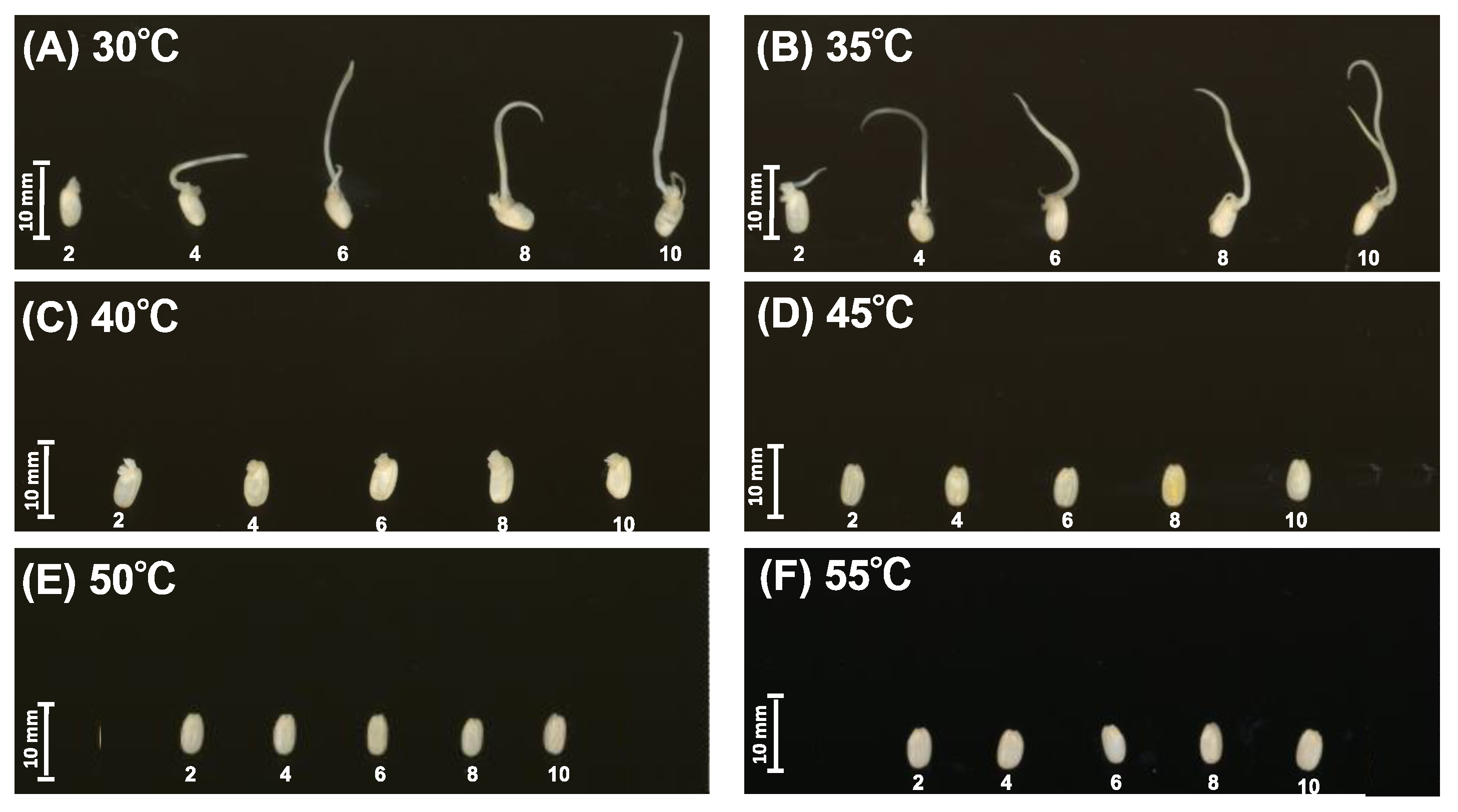
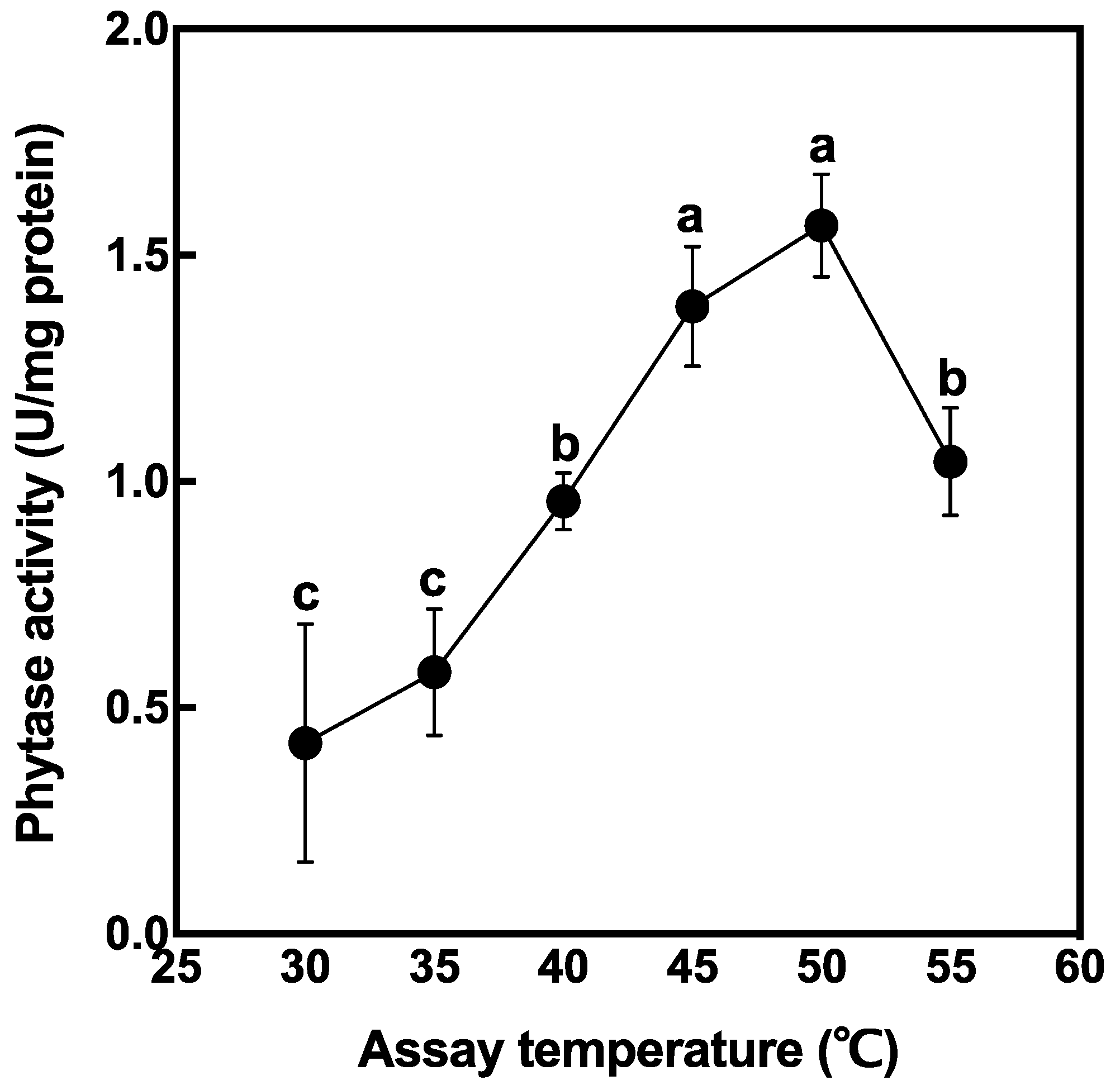
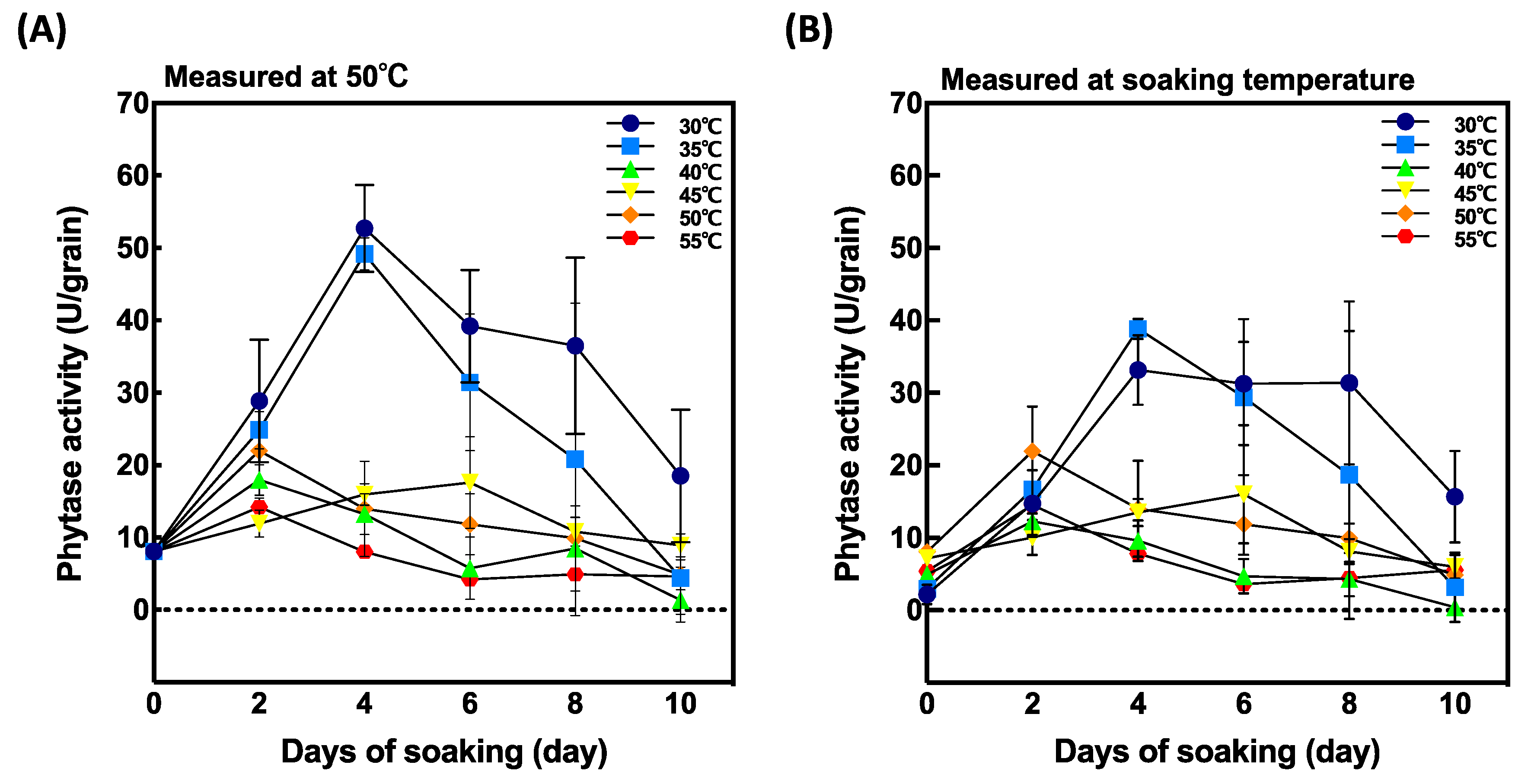
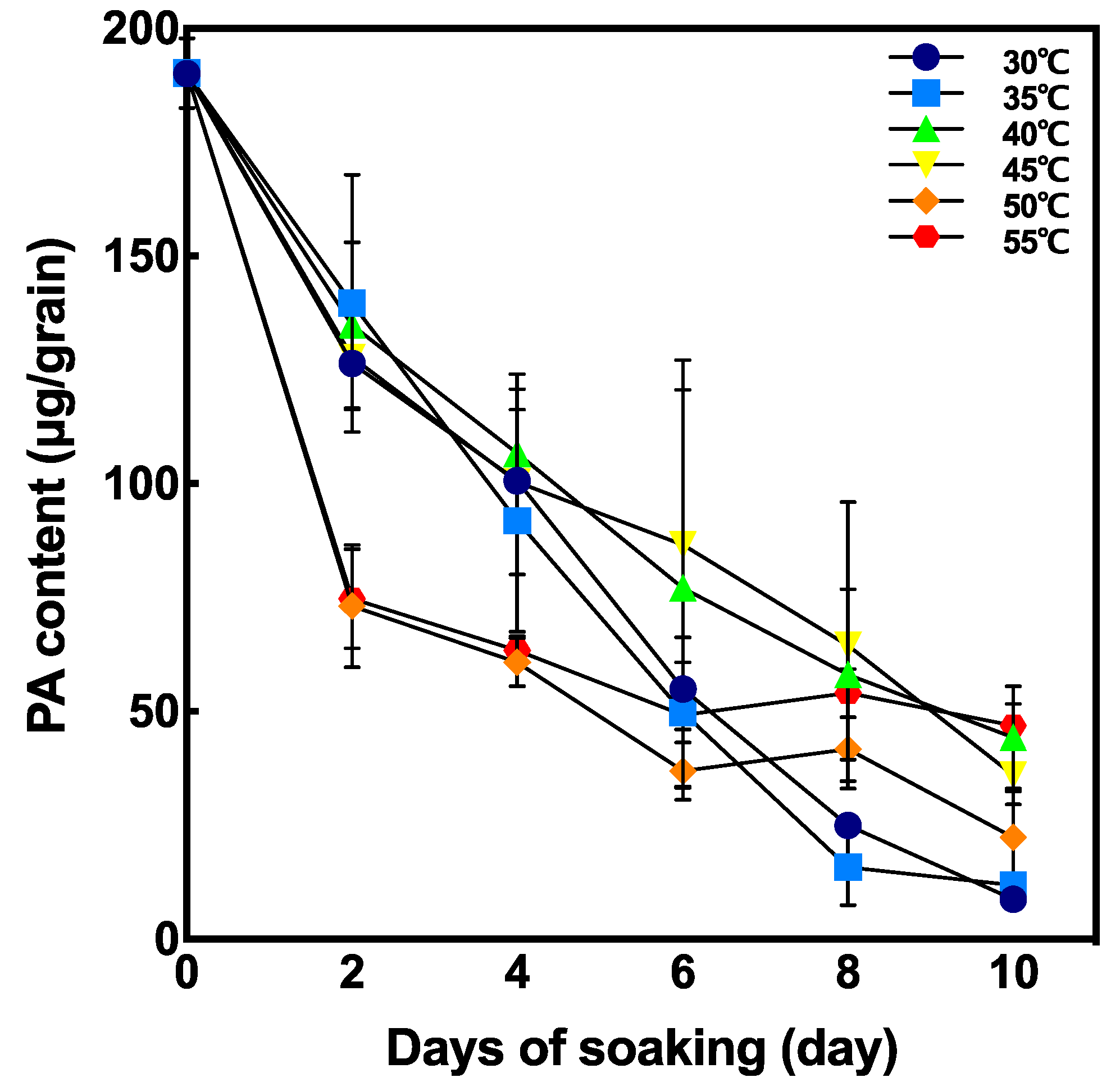

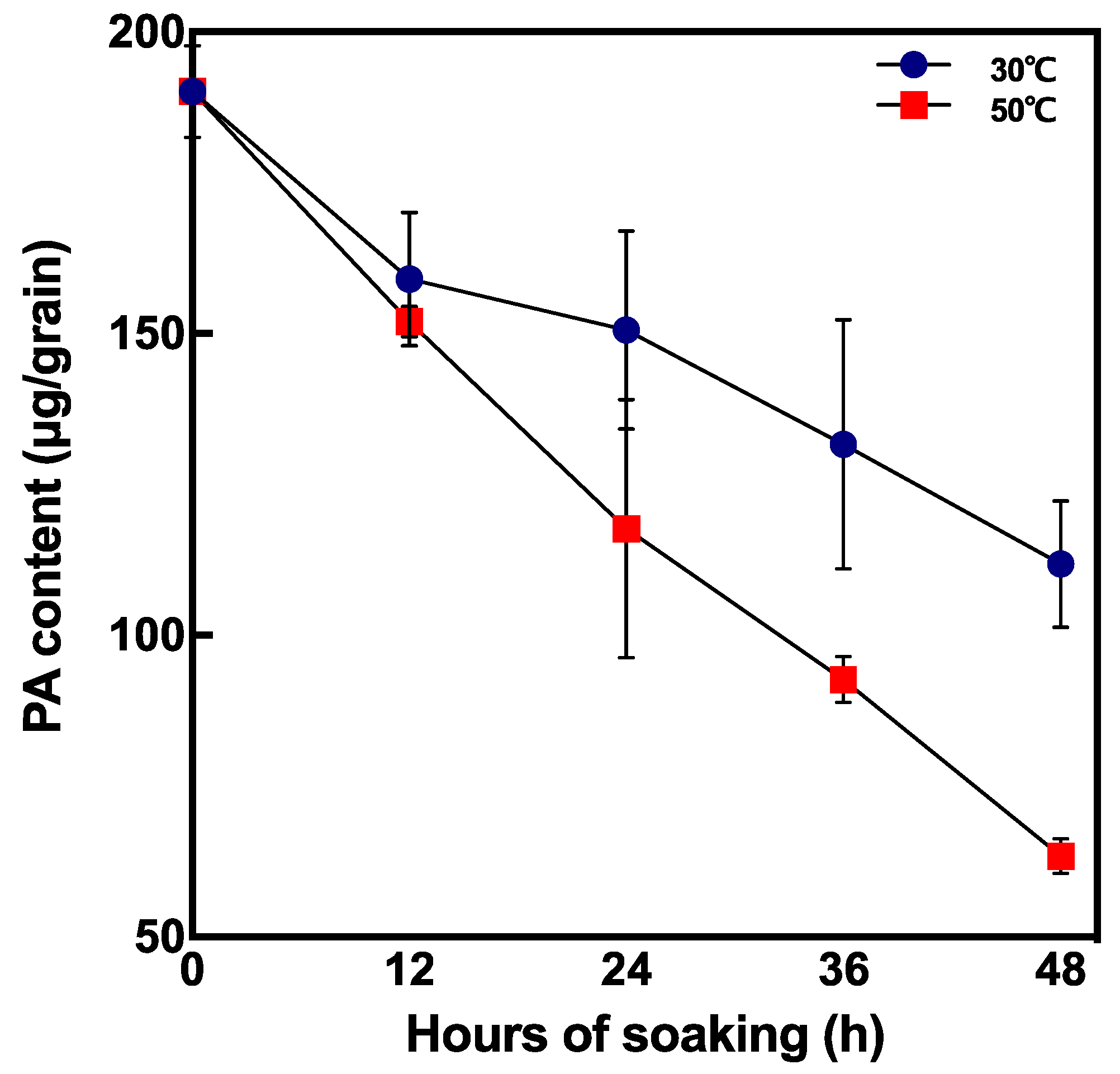
| Treatment | PA Content (μg/g) | Zn Content (µg/g) | TAZ (mg/d) | |||
|---|---|---|---|---|---|---|
| Non-soaked grain | 190.2 ± 7.6 a | (100) | 39.6 ± 3.5 a | (100) | 1.4 ± 0.1 c | (100) |
| Soaked grain (30 °C, 36 h) | 147.8 ± 20.9 b | (69) | 42.3 ± 2.5 a | (107) | 2.2 ± 0.2 b | (156) |
| Soaked grain (50 °C, 36 h) | 99.0 ± 17.0 c | (49) | 39.6 ± 3.2 a | (100) | 3.1 ± 0.2 a | (225) |
Publisher’s Note: MDPI stays neutral with regard to jurisdictional claims in published maps and institutional affiliations. |
© 2020 by the authors. Licensee MDPI, Basel, Switzerland. This article is an open access article distributed under the terms and conditions of the Creative Commons Attribution (CC BY) license (http://creativecommons.org/licenses/by/4.0/).
Share and Cite
Fukushima, A.; Uchino, G.; Akabane, T.; Aiseki, A.; Perera, I.; Hirotsu, N. Phytic Acid in Brown Rice Can Be Reduced by Increasing Soaking Temperature. Foods 2021, 10, 23. https://doi.org/10.3390/foods10010023
Fukushima A, Uchino G, Akabane T, Aiseki A, Perera I, Hirotsu N. Phytic Acid in Brown Rice Can Be Reduced by Increasing Soaking Temperature. Foods. 2021; 10(1):23. https://doi.org/10.3390/foods10010023
Chicago/Turabian StyleFukushima, Ayaka, Gun Uchino, Tatsuki Akabane, Ayaka Aiseki, Ishara Perera, and Naoki Hirotsu. 2021. "Phytic Acid in Brown Rice Can Be Reduced by Increasing Soaking Temperature" Foods 10, no. 1: 23. https://doi.org/10.3390/foods10010023
APA StyleFukushima, A., Uchino, G., Akabane, T., Aiseki, A., Perera, I., & Hirotsu, N. (2021). Phytic Acid in Brown Rice Can Be Reduced by Increasing Soaking Temperature. Foods, 10(1), 23. https://doi.org/10.3390/foods10010023






